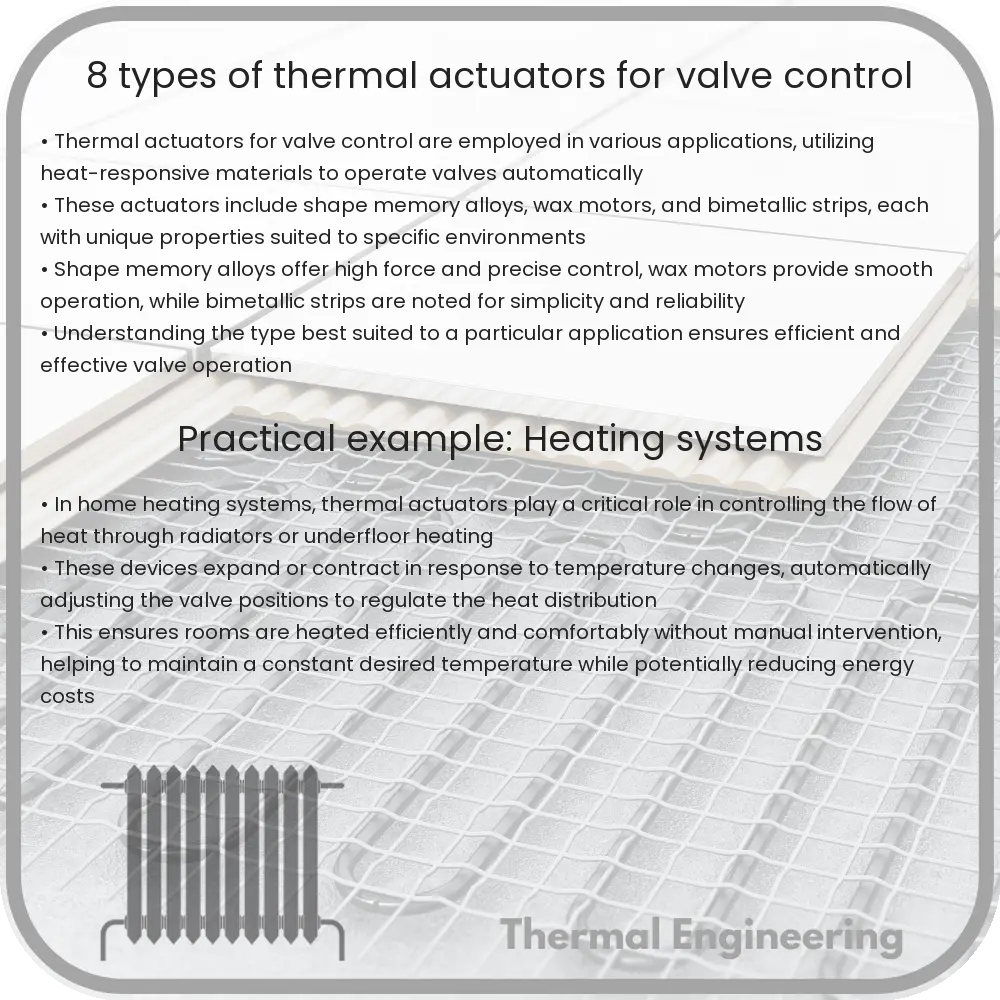Explore the functionality and types of thermal actuators used for precise valve control in response to temperature changes.

Understanding Thermal Actuators for Valve Control
Thermal actuators are devices used in various applications for controlling the flow of fluids through valves based on changes in temperature. These actuators utilize thermal energy to bring about motion and are commonly employed in systems where precise temperature control is crucial. There are several types of thermal actuators designed to suit different operational needs and environments. Here, we explore eight common types of thermal actuators used for valve control.
1. Shape Memory Alloys (SMA) Actuators
Shape Memory Alloys, particularly Nickel-Titanium alloys, are known for their ability to return to a predetermined shape when heated. SMA actuators use this property to actuate valve mechanisms. When the SMA is heated past its transformation temperature, it changes shape, causing the actuator to move and adjust the valve position accordingly.
2. Bimetallic Actuators
Bimetallic actuators consist of two metals with different coefficients of thermal expansion bonded together. As temperature changes, the differential expansion of these metals causes the bimetallic strip to bend. This bending movement is utilized to control the valve. They are simple, reliable, and commonly used in thermostatic controls.
3. Wax Motors
Wax motor actuators contain a sealed capsule filled with wax. When the wax is heated, it expands significantly, driving a piston outward, which in turn moves the valve. As the temperature decreases, the wax contracts, and a spring returns the piston to its original position. This type is widely used in plumbing and HVAC systems.
4. Gas-Actuated or Gas-Charged Actuators
These actuators use a gas-filled bellows or diaphragm that expands or contracts with temperature changes. The gas expansion applies pressure to a piston or a similar mechanism to move the valve. These actuators provide a smooth, gradual response and are effective over a range of temperatures.
5. Filled System Actuators
Filled system actuators work similarly to gas-charged actuators but use a liquid instead of a gas. The liquid expands with heat in a controlled manner, moving a diaphragm or a piston to adjust the valve. These actuators are particularly effective for precise control over a narrow temperature range.
6. Electric Thermal Actuators
Electric thermal actuators incorporate heating elements to initiate movement through thermal expansion. These actuators offer precise control and are often integrated with electronic control systems for automated responses to temperature changes. They are commonly found in modern industrial applications.
7. Magnetic Shape Memory (MSM) Actuators
Magnetic Shape Memory actuators use materials that change shape or deform in response to a magnetic field and temperature changes. These actuators provide rapid and precise control and are relatively new compared to other thermal actuators.
8. Thermally Responsive Polymers
Actuators using thermally responsive polymers operate on the principle that certain polymers expand or contract significantly with temperature changes. These materials can act directly as the actuating force, eliminating the need for mechanical parts. They offer advantages in terms of weight, cost, and simplicity.
Conclusion
Thermal actuators play a vital role in systems requiring reliable and precise temperature-dependent control. The type of thermal actuator chosen for a particular application typically depends on factors such as response time, control accuracy, environmental conditions, and budget. With advancements in materials science and engineering, the effectiveness and applications of thermal actuators are expected to grow, further enhancing their significance in industrial, automotive, and environmental technologies.